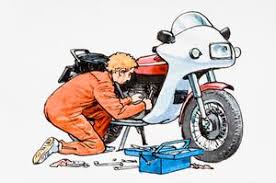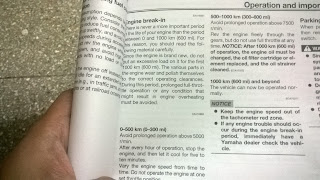Now that you finally have your ride, I bet people are
catching you just standing by and admiring it like a schoolboy checking out the
hot neighborhood babe. It happens and you should savor the indescribable
feeling of owning a gleaming set of wheels. Now to deal with the boring bit
(not for me though as I love to read, even if it is an instruction manual!) go
through the owner’s manual from cover to cover and make a mental note of the
important bits, namely the service intervals and the maintenance tips that
owners should follow to keep their rides as good as new.

Running in
This is a contentious topic in biking circles and some
believe that modern machines come run in from the factories and you can go TWO
(throttle wide open) from the get go. Many though still swear by the time
honored tradition of putting the machine through its paces by going easy on the
throttle for the first few thousand on the odo and let the mating parts of the
engine, brakes, tires and other components bed in.
If this happens properly, you should have an engine which runs smoother and
lasts longer with optimum fuel efficiency and performance. While I have
appended some links at the end of this post on the whole running in business,
my advice to you is to follow what the instruction manual says about running in
to the T, nothing more and nothing less. After all, the manufacturer who made
the machine is expected to know it best and crucially, it makes much easier
should any warranty claim arise in the future. Below is a snapshot of the
running in section from my Yamaha R15 manual. Its pretty simple and easy to
follow and most contemporary bikes will have a similar process. If you want to
take a leaf out of my book, while I stuck to the engine RPM limits (tachometer) and speeds for the most part, I was not
shy of opening the throttle (albeit for short bursts) and giving her the stick
once in a while. Especially for high revving sports bikes, I feel it helps for
the engine to explore the upper reaches of the powerband in the initial kms,
the trick is not to overdo it. Ensure that you do a mix of highway+city+ghat (if
you are lucky to be living in Bangalore/Pune) riding as it exposes the bike to
different riding conditions with frequent speed variations and gear changes.
Once the running in period is complete as per the manual, its TWO time!
http://www.team-bhp.com/forum/owning-car/67729-article-how-run-your-new-car.html
http://www.motorcycleextremist.com/Motorcycle-Engine-Break-in-the-Right-Way!.html
Caring for your ride
This is a comprehensive topic and for the finicky lot (myself
included) no amount of TLC is enough for their precious rides. Go ahead and
indulge yourself if you have the time and passion to spare but the following
quick tips and the links below should keep your machine ticking over for many
miles.
Engine oil and fuel
Again the owner’s manual should be the bible here. Ensure
that you are sticking to the grade specified by
the manual (the service centre will ensure this at least for the initial free
servicing but push pricey options in the same grade – politely decline if your
budget does not permit) A pricey synthetic
option over regular mineral ones (same grade) is not mandatory unless the
manual specifies, especially if the service intervals are frequent (synthetics last longer). In fact,
given an option, its best to run on mineral for the first 8 – 10k kms and then
switch to synthetic as it may result in a better run in engine. Be particular
about the drain intervals: apart from ensuring warranty, all modern engines ask
of you is to have the oil replaced periodically - not doing that is sacrilege.
Most manuals will specify both distance and time (3/6 months) intervals for the next
service: do not neglect this even if you haven’t
clocked enough on the odo as oil starts degrading the moment its poured inside
the engine and needs to be replaced if the time interval is achieved, irrespective of the distance completed. Moving on to the topic of fuel (petrol or gasoline in this case) I don’t need to tell you how critical it is to run on clean stuff.
While we do not oversee the refining and transportation of the stuff to fuel
pumps, we can certainly choose which pump to go to, at least in the city.
If a pump looks deserted most of the time or something looks amiss, its usually
for a good reason – there are certain fuel pumps in all cities which are
notorious for peddling adulterated fuel or cheating customers by short fueling
tricks. Look for COCO (company
owned company operated) outlets of any of the state owned refineries; I have a
preferred set of pumps in my city where I generally refuel from and go with my
eyes closed to any Shell outlet anywhere (for those living in Bangalore, Pune and
Chennai) Look for the bigger outlets while hitting the highways. Don’t wait for
the fuel tank to go into reserve before refueling, refuel the moment the level
drops below 25% capacity. Running on fumes is the quickest way to fry your fuel
pump (in a fuel injected model) needing a costly replacement.
Cleaning and lubing the bike and the drive chain
If you care for your ride the least that you would do is to
give it a good wash and often, and that’s partly because its pretty much the
only thing that does not need expertise, or so we think. Washing (or hosing it
down as some do) a motorcycle is different from washing a car; a bike
(especially performance ones) is an exposed piece of machinery with everything
from the drive chain to the radiator (for liquid cooled ones) to the wires
running down the instrument cluster, in plain view and open to the elements.
While our rides are ‘waterproof’ to an extent and they can happily ride through
rain and slush, they are not designed to withstand modern pressure washers
which can wreak havoc with the delicate radiator fins for example, by bending
them and fouling with the electrical systems. Be gentle, use a couple of
buckets of water (one for the soap water and the other with clean water to rinse the
sponge in) with branded car shampoo (no detergents or household cleaners please as they are not formulated for use on automotive paint surfaces), sponge and a microfiber cloth to
rinse off the damp surface. Do not do this often (I do it once a fortnight or
when the bike gets really dirty) since you may do more damage to painted
surfaces by leaving swirl marks if you are not doing it right and wash and dry
in the shade as direct sunlight will leave water spots since it will dry water faster than
you can pat it down with a cloth. Do not wash immediately after a hard ride; wait for the bike to cool down to avoid splashing water on a hot
engine and start the bike after you are through with the wash and wipe ritual to drive out any residual moisture.
Most manuals advise that the chain be cleaned and lubed every 500 kms and as I
had mentioned earlier, its always good to follow what the manual says. As for
me, since I live in Bangalore and my bike sees more highways and ghats with
perfect tarmac than dustbowls, I tend to clean the chain every 1000 kms and
apply lube every 500 kms or if it seems dry/have been ridden in the rains. Modern
day ‘O-ring’ type chains come with lubricant
inside the rollers sealed from the factory, but the joints between links still
need to be lubed.
Tip – You can combine the chain cleaning + lubing process along
with your bike washing ritual. Spray the chain cleaner/wipe the chain with
kerosene or similar solvent before washing the bike. Take the bike out for a
quick spin after washing so that the chain is warm (helps in absorbing the lube
inside the rings as the chain cools - you will waste precious lube by spraying it onto a cold chain), ensure that you put the bike on the centre/paddock stand and turn the ignition off before you start lubing – this
is important as many a finger have been lost while lubing the chain
with the engine in gear! Spray the lube lightly (or use gear oil if you are on
a budget – you can apply it with a thin paint brush) directly on the O rings
and leave the bike parked for a few hours (preferably overnight) for the lube
to seep in. A dry chain will make for a noisy ride and will also wear your
sprocket out in addition to wearing themselves out sooner. I use Yamalube/Motul chain cleaner and lube (sold separately). There are several brands available and you can pick one which suits your budget. Do wear protective gardening gloves while handling the chain!
The better informed amongst us also adjust the chain slack, take apart the brake calipers to clean the pads, change oil etc etc. If you are a novice and can just about get the ignition going and slotting your ride in gear, follow the above tips and ensure you are sticking to the service intervals at the workshop. That should be enough to keep your motorcycle happily chugging along!
Next up - Riding gear.
